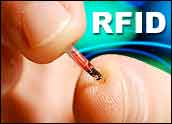
Without a doubt, adoption and use of radio frequency identification (RFID) accelerated dramatically when Wal-Mart and the Department of Defense gave their respective suppliers marching orders to implement the technology.
However, suppliers for the most part were not happy with the additional costs and resources that had to be diverted into these projects — expenditures that would not benefit them except in keeping the business.
“Most suppliers that are complying with the mandates are doing it because they have to,” Martyn Mallick, Sybase iAnywhere’s director of RFID technologies, told CRM Buyer.
Voluntary Expansions
That said, some forward-looking companies are voluntarily expanding their use of RFID because they want to realize the benefits it can offer — in the supply chain and elsewhere.
This is occurring in parking garages, for example. Spain’s postal service is another illustration. So are a few deployments on shopping carts at certain grocery stores. In each of these cases, the technology solves a vexing probem — and in some cases a seemingly simple one. The use of RFID on shopping carts, for example, saves a grocery store the $200 it would cost to replace it, Mallick noted.
Certainly, RFID’s primary ROI (return on investment) lies in the supply chain efficiencies that it can deliver. Part 2 of this series will address how firms are proactively using RFID technology to deliver better products more cost effectively to their customers.
Parking Frustration
Bangalore, India, is notorious for its traffic jams. As the staff at Infosys has learned over the years, the congestion doesn’t end once they pull into the company’s headquarters. With more than 14,000 employees, it is one of the world’s largest software development campuses. The parking garage is a multi-level, six-story building designed for 1,500 cars.
The company’s former system had employees show necessary identification to enter and exit the garage, which required stopping the vehicle, rolling down the windows and reaching out to the reader unit to flash the card, explained Girish Ramachandra, a delivery manager who leads research and development and solutions delivery in the RFID solutions practice division at Infosys.
“This would cause bumper-to-bumper back-up during peak traffic,” he told CRM Buyer. “Also, the availability of empty slots in each level was gauged manually and at times could get frustrating to drive around to find a place to park,” he said.
Turning to RFID
The company decided address the situation by turning to RFID technology as a solution. It realized that a conventional approach — that is, active RFID — would work but would not be economically viable because of the higher unit costs and maintenance for battery life.
“Hence, we explored a cost-effective solution that combined EPC Gen 2 UHF RFID passive tags, which has a very low unit cost vis-a-vis active RFID, with sensors and intelligent software,” Ramachandra stated.
The system now in place automatically detects cars with passive RFID tags — in the form of sticky labels — on the windshield when they are in range of an antenna array. The boom barrier opens once the cars are authenticated. Floor-mounted sensors are used to define use case boundaries for the RFID read point, and also used at each level to count cars to determine empty slot availability, he explained.
Tracking the Mail
In Spain, the postal service has been experimenting with RFID technology to determine where bottlenecks exist in its delivery system, Mallick said.
Using passive RFID tags that are placed on randomly selected letters and packages, the postal service is able to monitor them as they move through the postal system. It is very similar to a “last seen” use of RFID in rail operations — a reader transmits when a RFID-equipped car passes its station. It is also reminiscent of the system same day delivery services have implemented for their packages, which track a package as it moves from the airplane or truck to the consolidation area then to the next leg of the journey.
The system “allows the postal system a better view into their internal operations as a letter or package moves through the system,” he noted.
Unlike a same-day delivery service, it is not tracking an individual letter but trying to detect areas or parts of the operations where the mail can back up or go astray, Mallick noted. “It is a very innovative use of passive tags,” he said.
An Educational Setting
Oakton Community College in Des Plaines, Ill., believes RFID technology is important enough to have its own RFID training lab and curricula designed to prepare students for RFID opportunities in the workforce — a rarity among community colleges.
The training facility emulates a factory floor where workers move tagged boxes or pallets through the passageway allowing inventory processing to occur automatically.
“We have entry level classes in literacy, use of middleware as well as a survey of industrial applications,” Robert Sompolski, dean of mathematics and technologies at the college, told CRM Buyer.
While the college is focusing on manufacturing applications, it is also exploring the possibilities for homeland security and pharmaceutical deployments, he added.
“We are very interested, for example, in the electronic pedigree activities which pharmaceutical companies are now exploring,” Sompolski explained, noting the college has a large pharma-biotech lab.
The college, which also assists in training first responders in various exercises, is interested in tying RFID technology with, for example, hazmat rescue operations, he stated. Related activities would include urban search and rescue and weapons inventory at police and other law enforcement agencies, Sompolski continued.
“The Department of Defense uses RFID to keep track of equipment in the field. Urban search and rescue teams use very similar equipment. They must be able to identify where it is quickly so they can strategize how to use it in an emergency situation. RFID could do that for them,” he concluded.













































